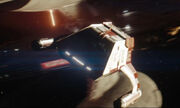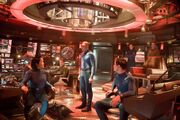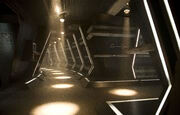m (format) |
|||
| Line 38: | Line 38: | ||
=== Background information === |
=== Background information === |
||
| − | The Artisan prop and model shop of [[Quantum Mechanix]], QMx FX Cinema Arts, was asked to illustrate the history of space flight with models for ''Star Trek: Into Darkness''. They constructed fourteen models in total. On their website, there was a picture of the USS ''Kelvin'' model. |
+ | The Artisan prop and model shop of [[Quantum Mechanix]], QMx FX Cinema Arts, was asked to illustrate the history of space flight with models for ''Star Trek: Into Darkness''. They constructed fourteen models in total. On their website, there was a picture of the USS ''Kelvin'' model. [http://www.qmxonline.com/news/stid-history-of-starflight-models/] |
==== Identifying the ''Kelvin'' ==== |
==== Identifying the ''Kelvin'' ==== |
||
Revision as of 18:54, 22 May 2013
AT: "xx"
The USS Kelvin (NCC-0514) was a Federation Kelvin-type starship that was in service with Starfleet in the early 23rd century. In 2233, the Kelvin was under the command of Captain Richard Robau; his first officer was Lieutenant Commander George Kirk. Kirk's wife, Winona, was also aboard the ship at that time while she was pregnant with their son, James T. Kirk.
Alternate reality
On stardate 2233.04, the Kelvin was on a mission 75,000 kilometers from the Federation-Klingon border when it encountered a black hole created in 2387 by the detonation of a red matter device, subsequently creating an alternate reality. Initially, the Kelvin's crew considered whether this phenomenon was of Klingon origin, although that theory was later dismissed.
The time of the encounter also marked Winona Kirk entering labor with her and George Kirk's son.

The Kelvin prepares to ram into the Narada
As the Kelvin was observing the black hole, an unidentified vessel, the Narada, a 24th century Romulan mining vessel commanded by Captain Nero, emerged from the future. When the Narada discovered the Kelvin, it quickly charged its weapons and opened fire on the much smaller Kelvin. In response, the Kelvin went to red alert and began fighting off torpedoes launched from the Romulan vessel. The first hit took out the warp drive and reduced main power to thirty-eight percent. The second torpedo disabled the Kelvin's atmospheric stabilization and collapsed its shields. The Kelvin was easily overcome, but the attack was halted by Nero's first officer, Ayel, who requested that Captain Robau personally come aboard Nero's vessel to discuss terms of a cease fire. Robau obliged the request and transferred to the Narada via shuttlecraft, leaving George Kirk in command. Robau's final orders to Kirk were to evacuate the ship using all available shuttlecraft, and to use the autopilot to set the Kelvin on a collision course with the Narada.
During the meeting on the Narada, Robau was first interrogated by Ayel and was summarily killed by Nero. Tracking Robau's life signs, the Kelvin crew became aware of Robau's execution instantly. George Kirk immediately ordered evasive action and the firing of all weapons, and the Kelvin continued taking fire from the Narada. Knowing that the Kelvin would be no match for the onslaught of missiles from the Romulan ship, Kirk ordered General Order 13: the evacuation of the ship.

Medical shuttle 37 flees the Kelvin
Once all shuttlecraft had been launched, Kirk used the Kelvin to cover their escape. With no other options left, he plotted a collision course, intending to use the ship's autopilot to ram the Narada. Kirk was, however, forced to remain on the Kelvin, rather than join his wife aboard medical shuttle 37, when it was discovered that the Narada had destroyed the Kelvin's autopilot function, leaving him to pilot the ship manually. Kirk then piloted the ship until it rammed into the Narada, severely damaging it. The Kelvin was destroyed, but Kirk's sacrifice ensured the survival of the escaping shuttles. While Kirk only served as captain of the Kelvin for a mere twelve minutes, his sacrifice saved the lives of some eight hundred people, including those of his wife and newborn son.
After the Kelvin's destruction, Christopher Pike wrote a dissertation on the Kelvin and the actions of George Kirk, its commanding officer at the time of its destruction. Pike later made reference to this dissertation and his knowledge of George Kirk to Kirk's son, daring him to do better than his father and enlist in Starfleet. (Star Trek)
| The Flight of the Narada |
|---|
| Attack on the USS Kelvin (2233) • Destruction of Vulcan (2258) • Battle of Earth (2258) |
In 2259, a replica of this starship was on display in the office of Admiral Alexander Marcus. (Star Trek Into Darkness)
Appendices
Related topics
Background information
The Artisan prop and model shop of Quantum Mechanix, QMx FX Cinema Arts, was asked to illustrate the history of space flight with models for Star Trek: Into Darkness. They constructed fourteen models in total. On their website, there was a picture of the USS Kelvin model. [1]
Identifying the Kelvin

A concept sketch for the USS Iowa, which later became the Kelvin
The Kelvin was named after physicist and engineer Lord Kelvin as well as Harry Kelvin, the grandfather of Star Trek director and producer J.J. Abrams. [2] The registry number of the Kelvin is Harry Kelvin's birthday. (audio commentary, Star Trek Special Edition/Three-disc Blu-ray)
In early stages of the film's development, the ship was named the USS Iowa. [3] While known by this eventually unused name, the vessel was given a registry number of 1201. [4] In a later interview with screenwriters Alex Kurtzman and Roberto Orci, Kurtzman explained that the ship's initial name was to have been "our nod" to the fact that the prime universe James T. Kirk had been semi-established as having been born in Iowa. "Then we decided that was too radical," Kurtzman said of the reference. Orci further explained that the writers imagined that – in the prime timeline, shortly prior to the birth of James Kirk – the Kelvin would have successfully completed the return journey to Earth, safely delivering the as-yet unborn boy, as well as his parents, to the planet. (Star Trek Magazine issue 146, p. 38)
Also according to Orci, the telemetry data which the Kelvin recorded of the technologically advanced Narada during the battle was probably brought back to Starfleet via the surviving shuttles. Orci additionally implied that Starfleet's exposure to this data may explain why its ships and technology appear different in the alternate universe. [5] J.J. Abrams also said, in an interview with MTV, that readings from the Narada "inspired ideas and technology that wouldn't have advanced otherwise." [6]
Robau actor Faran Tahir once made several speculations about the Kelvin, such as suggesting that – prior to its destruction in the alternate reality – it had a long history that included having been in previous battles. He reckoned, "The Kelvin is a ship that's been sent out to the uttermost reaches of the explored universe at that point [....] The Kelvin has been out there and has run the gamut of creating peaceful situations out of dangerous situations [....] I think it's a great parallel that the Kelvin is very much what Enterprise ends up being later in the story. It is a prototype and I would suggest that the events of that ship were taught as a model at the Academy." (Star Trek Magazine issue 145, p. 87)
Creating Kelvin scenes
Alex Kurtzman once observed that – with the attack on the USS Kelvin placed at the start of the film Star Trek – the scene retains a sense of initial confusion for the audience, which the writers much desired for the movie's beginning. (Star Trek Magazine issue 146, p. 39)
The opening shot of the Kelvin, a sweeping forty-second camera move, was not planned for in initial previsualization footage, created during the early stages of production by David Dozoretz and an affiliated team at Paramount. It was only once J.J. Abrams and his editors began combining live-action and previz footage that they realized they wanted the previz to be different from what had originally been planned. "They decided they wanted to tell a different story in quite a few sequences," recalled Industrial Light & Magic animation supervisor Paul Kavanagh. ILM consequently began creating their own previz shots, including the initial view of the Kelvin, which was orchestrated by ILM during principal photography at Paramount. "J.J. wanted to create a sense of mystery in the shot," Kavanagh explained. He ultimately thought this notion was achieved, commenting, "Each piece of the shot revealed a little bit more of the story, keeping the audience intrigued until the end, when we finally revealed this starship." (Cinefex, No. 118, p. 48)
As the movie's director, J.J. Abrams discovered that filming certain portions of the attack on the Kelvin required more thorough planning than the majority of the film. (audio commentary, Star Trek Special Edition/Three-disc Blu-ray) The exterior damage sustained by the Kelvin during the battle was intricately planned in a diagram of the starship. (Star Trek - The Art of the Film, p. 25)

the set for the Kelvin's bridge, during production
Of all the shipboard scenes in the film, the ones set aboard the Kelvin were filmed first. As such, Director of Photography Dan Mindel considered the shooting of the Kelvin scenes to be a "trial run" for the upcoming filming of the Enterprise sets. "We went onto the Kelvin knowing that we were going to be blind for the first few days until we started seeing dailies from those sets, then we could take notes and add whatever we wanted to for the Enterprise, which hadn't been built yet," Mindel remarked. "We wanted to make the Kelvin a lot darker and less welcoming and positive than the Enterprise was going to be, so everything is muted in there. It is in a really sticky situation in the story anyway, so it deteriorates very quickly in front of your eyes! It does feel like it is in distress." (Star Trek Magazine issue 146, p. 44)
Location filming that was involved in depicting the destruction of the Kelvin's lower decks took "about a week," according to stunt coordinator Joey Box. He originally scouted the location with J.J. Abrams, Dan Mindel, 1st Assistant Director Tommy Gormley and several other department heads. "We prepped for about five days in the environment, and then at the end of the movie, we came back there and picked up some bits and pieces they hadn't got," said Joey Box. "I had at least 15 guys there: that was all expediting the evacuation of the ship and showing the destruction of the Kelvin from the inside out." (Star Trek Magazine issue 146, pp. 61-62) Achieving this spectacle of disaster took lots of special effects, such as fire as well as (in the words of Winona Kirk actress Jennifer Morrison), "explosions, falling sparks, water pouring out [and] things shaking." These effects normally took two hours to set up. (Star Trek Magazine issue 145, p. 96)
When creating the effect of a wall rupturing moments before a female officer is pulled through it, the film's physical effects supervisor, Burt Dalton, and the special effects department were responsible for representing that ill-fated part of the ship. "We blew out the side of the set practically," said Dalton. Other elements of the same shot were done in CGI, however. (Cinefex, No. 118, p. 54)
According to J.J. Abrams, the entire Kelvin sequence, including the CG footage, was shot "months, if not over a year, apart." Cutting the sequence together involved much concentration on it; Roberto Orci has stated that "it felt like, every time I walked into the editing room," the sequence was being worked on. (audio commentary, Star Trek Special Edition/Three-disc Blu-ray)
In fact, the Kelvin sequence was revised considerably during post-production. Wherever J.J. Abrams and his editors did not yet have previsualization footage, they inserted black cards with shot descriptions. Paul Kavanagh and ILM visual effects supervisor Roger Guyett then discussed the battle with Abrams and his editors, giving consideration to the types of shots Abrams might want to include in the conflict. (Cinefex, No. 118, pp. 48 & 51)
The idea of the Kelvin ramming the Narada was not visualized until after ILM set to work on the previz. "In the revised scene, J.J. decided it would be more dramatic if Kirk defended the escaping shuttles by taking the Kelvin on a suicide run into the Narada," Paul Kavanagh remembered. "That was not part of the original cut." The ship's destruction eventually involved computer-generated fireball effects. A physical effects rig was also used on the set for the vessel's bridge, making George Kirk appear to be slammed toward the front of the ship from out of the command chair. (Cinefex, No. 118, pp. 48, 51 & 54)

The mysterious corridor on NCC-1701.com
One of the viral promotion sites, at NCC-1701.com, occasionally showed a picture of a mysterious corridor, supposedly on the Enterprise. It was, in fact, a corridor from the Kelvin, seen very briefly while George Kirk was in command.
Apocrypha
While dialogue in the film explicitly states that the Kelvin's warp drive was taken out early in the attack, according to the first issue of the Star Trek: Nero comic series, George Kirk was somehow able to restore it and activate the drive at the precise moment of impact, consequently disabling the Narada.
A computer-generated depiction of the Kelvin was included in the 2011 edition of the Ships of the Line calendar, in the image for February (entitled "U.S.S. Kelvin–On Patrol"). Created by Tobias Richter, this image shows the starship passing through a planetary system with its warp nacelle energized, nearest a ringed planet with two other planets nearby.
External link
- Template:NCwiki
